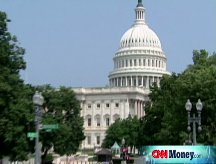House takes Paulson to task on bailout
Treasury chief responds to criticism of the progress of $700B bank rescue plan; lawmakers push for additional help for homeowners.
 |
| Treasury Secretary Henry Paulson (left) and Federal Reserve Chairman Ben Bernanke offered Congress details on the progress of the $700 billion bailout program Tuesday. |
NEW YORK (CNNMoney.com) -- Lawmakers challenged Treasury Secretary Henry Paulson on his handling of the $700 billion bank bailout program and stressed the importance of doing more to help homeowners.
Joined by Federal Reserve Chairman Ben Bernanke and Federal Deposit Insurance Corporation Chairman Sheila Bair, Paulson impressed upon members of the House of Representatives that his agency has responded appropriately in what has been a rapidly changing and painful crisis that has roiled the entire global financial system.
"When the facts changed and the circumstances changed, we changed the strategy," Paulson told members of Congress. "We didn't implement a flawed strategy. We implemented a strategy that worked."
One of the biggest criticisms that regulators have faced since the bill was signed into law by President Bush last month was the decision to change the focus of the program from buying up toxic mortgage assets from banks to using the $700 billion to take ownership stakes in them.
When Paulson and Bernanke first pitched the bailout to lawmakers in September, they indicated that it was imperative that the government rid banks of the worst-performing assets on their balance sheets.
Many lawmakers expressed frustration that this part of the bill, which has become known as the Troubled Asset Relief Program, or TARP, appears to have been abandoned.
"We're trying to figure out - those of us that extended ourselves on the vote for the bailout - the 180-degree change that you made in policy," said Rep. Paul Kanjorski, D-Pa. asked Paulson. "Do we have a plan? Where are we going?"
Instead Treasury launched a massive program to inject $250 billion directly into financial institutions by buying their stocks in order to help thaw frozen credit markets and get skittish banks lending again. Agency officials have argued that this approach was a less cumbersome solution than buying assets and would go a longer way towards helping the financial system.
What has also vexed members of Congress, however, is that those direct investments in banks are not doing much to help thaw the frozen credit markets and get banks lending again. Instead, there are concerns that banks are either hoarding the money or putting it towards other uses, such as acquiring weaker rivals.
But since many institutions have not received money from the capital purchase program, it's still unclear what the impact of these investments will be.
As of Monday, the Treasury Department has laid out $158.56 billion to banks, including $125 billion to the original nine institutions, including Citigroup (C, Fortune 500), JPMorgan Chase (JPM, Fortune 500), Goldman Sachs (GS, Fortune 500) and Bank of America (BAC, Fortune 500). The additional $33.56 billion has been disbursed to 21 other banks.
That number could grow as the deadline for publicly traded banks to sign up for the program just expired Friday. Treasury also extended the deadline for privately owned banks to sign up for the program until Dec. 8.
"Remember, this is early days," said Paulson. "In terms of the capital, it has just gone out and a lot of it still hasn't gone out to the banks."
Lawmakers were also curious to find out what regulators plan next.
Paulson said last week that the Treasury and the Fed may establish a program aimed at providing help to consumer finance companies.
As is the case with mortgages, many consumer finance companies sell packages of other consumer loans to investors in order to generate cash needed to generate new loans. Such firms have found it increasingly difficult to fund auto loans, student loans and credit cards as demand for pools of these loans has dried up.
However, a number of lawmakers indicated Tuesday that more needed to be done for struggling homeowners.
Several members of Congress pressed Paulson about why he was reluctant to get behind a plan proposed last week by Bair. Under that plan, housing payments for borrowers two months or more delinquent would be reduced and the government would share part of the losses that servicers or investors could suffer. She reiterated those plans Tuesday.
"Minimizing foreclosures is essential to the broader effort to stabilize global financial markets and the U.S. economy," Bair told members of Congress.
Paulson again expressed his reluctance to providing TARP money for such a program. He hinted that such type of assistance may not necessarily target those homeowners it is aimed at helping. But he didn't completely rule it out.
"I have not said no," Paulson told lawmakers Tuesday. "In designing broad-based programs, there is a balance to getting money to those who need it as opposed to those who don't need it."
Other industries that have been hit hard by the economic downturn have lobbied hard to get a portion of the bailout package, most notably the nation's Big Three automakers.
Executives of General Motors (GM, Fortune 500), Ford Motor (F, Fortune 500) and Chrysler LLC are pressing for $25 billion from the government and are scheduled to testify at another Congressional hearing later Tuesday. But an automaker bailout has faced plenty of resistance from the White House and Republican lawmakers.
Paulson, however, has said publicly in recent days that he would not ask Congress for the remainder of the $700 billion package before the end of the year. Instead, it would be up to the next session of Congress to approve the remaining bailout money so that President-elect Barack Obama and his administration can allocate it as they see fit. ![]()


